Design and development
After World War II the Air Ministry issued specifications for a wide variety of rocket engines, both liquid and solid-fuelled. Napier responded with the design of a liquid-fuelled rocket which used catalysed hydrogen peroxide (H2O2), in the form of High-Test Peroxide (HTP) as oxidiser and Kerosene as fuel. [1]
The Scorpion was a regeneratively-cooled HTP (High Test Peroxide/Kerosene) bi-propellant rocket engine. Fuel and oxidiser were pumped by a single shaft turbo-pump driven by super-heated steam, generated by catalysing HTP. Engine starting was achieved by an electric pump supplying HTP to the turbo-pump decomposition chamber. Once started, a bleed off the turbo-pump oxidiser outlet fed the turbo-pump decomposition chamber to maintain flow of fuel and oxidiser. Due to the single-shaft turbo-pump operating both fuel and oxidiser pumps, flow of fuel and oxidiser were automatically maintained at the correct ratio. The Kerosene fuel is ignited thermally by the super-heated steam from HTP, decomposed by passing over a catalyst in a decomposition chamber, which is injected simultaneously into the combustion chamber. [2] [3] [1]
First run on 19 May 1956, the N.Sc.1 Scorpion was also fired in the air on the following day, mounted in the bomb-bay of an English Electric Canberra B.2.
Double Scorpion
The Double Scorpion engine was simultaneously developed with the single-chamber Scorpion, consisting of two Scorpion engines mounted together with each unit individually controllable, developing double the thrust. From 1956 Double Scorpion engines were fitted experimentally to two Canberra light bombers, to improve high altitude performance. [4] On 28 August 1957 WK163, fitted with a Double Scorpion, broke the world altitude record, exceeding 70,000 ft (21,000 m). [5] [6] [7] [8]
The Double Scorpion was also considered for use in the English Electric P.1A interceptor (which gave rise to the Lightning) and Aerojet General was chosen for projected United States production.
Triple Scorpion
A triple-chamber version was also developed as the Napier Triple Scorpion, emerging as a Double Scorpion with a third chamber mounted centrally under the other two. [2]
Cancellation
The Scorpion project was cancelled in February 1959, at a reported total cost of £1.25 million. [9]

A hybrid-propellant rocket is a rocket with a rocket motor that uses rocket propellants in two different phases: one solid and the other either gas or liquid. The hybrid rocket concept can be traced back to at least the 1930s.
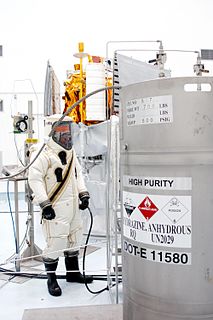
A hypergolic propellant combination used in a rocket engine is one whose components spontaneously ignite when they come into contact with each other.

A rocket engine uses stored rocket propellants as the reaction mass for forming a high-speed propulsive jet of fluid, usually high-temperature gas. Rocket engines are reaction engines, producing thrust by ejecting mass rearward, in accordance with Newton's third law. Most rocket engines use the combustion of reactive chemicals to supply the necessary energy, but non-combusting forms such as cold gas thrusters and nuclear thermal rockets also exist. Vehicles propelled by rocket engines are commonly called rockets. Rocket vehicles carry their own oxidizer, unlike most combustion engines, so rocket engines can be used in a vacuum to propel spacecraft and ballistic missiles.
A propellant or propellent is a chemical substance used in the production of energy or pressurized gas that is subsequently used to create movement of a fluid or to generate propulsion of a vehicle, projectile, or other object. Common propellants are energetic materials and consist of a fuel like gasoline, jet fuel, rocket fuel, and an oxidizer. Propellants are burned or otherwise decomposed to produce the propellant gas. Other propellants are simply liquids that can readily be vaporized.

A liquid-propellant rocket or liquid rocket utilizes a rocket engine that uses liquid propellants. Liquids are desirable because they have a reasonably high density and high specific impulse (Isp). This allows the volume of the propellant tanks to be relatively low. It is also possible to use lightweight centrifugal turbopumps to pump the rocket propellant from the tanks into the combustion chamber, which means that the propellants can be kept under low pressure. This permits the use of low-mass propellant tanks that do not need to resist the high pressures needed to store significant amounts of gases, resulting in a low mass ratio for the rocket.

The Reaction Motors LR99 engine was the first large, throttleable, restartable liquid-propellant rocket engine. Development began in the 1950s by the Reaction Motors Division of Thiokol Chemical Company to power the North American X-15 hypersonic research aircraft. It could deliver up to 57,000 pounds force of thrust with an Isp of 279 seconds. Thrust was variable from 50 to 100 percent, and the restart capability allowed it to be shut down and restarted during flight when necessary.
High-test peroxide (HTP) is a highly concentrated solution of hydrogen peroxide, with the remainder consisting predominantly of water. In contact with a catalyst, it decomposes into a high-temperature mixture of steam and oxygen, with no remaining liquid water. It was used as a propellant of HTP rockets and torpedoes, and has been used for high-performance vernier engines.
The highest specific impulse chemical rockets use liquid propellants. They can consist of a single chemical or a mix of two chemicals, called bipropellants. Bipropellants can further be divided into two categories; hypergolic propellants, which ignite when the fuel and oxidizer make contact, and non-hypergolic propellants which require an ignition source.

The staged combustion cycle is a power cycle of a bipropellant rocket engine. In the staged combustion cycle, propellant flows through multiple combustion chambers, and is thus combusted in stages. The main advantage relative to other rocket engine power cycles is high fuel efficiency, measured through specific impulse, while its main disadvantage is engineering complexity.

The de Havilland Spectre was a rocket engine built by the de Havilland Engine Company in the 1950s. It was one element of the intended mixed power-plant for combination rocket-jet interceptor aircraft of the Royal Air Force, such as the Saunders-Roe SR.177.

The Armstrong Siddeley, later Bristol SiddeleyGamma was a family of rocket engines used in British rocketry, including the Black Knight and Black Arrow launch vehicles. They burned kerosene fuel and hydrogen peroxide. Their construction was based on a common combustion chamber design, used either singly or in clusters of up to eight.

The Armstrong Siddeley Stentor, latterly Bristol Siddeley BSSt.1 Stentor, was a two-chamber HTP rocket engine used to power the Blue Steel stand-off missile carried by Britain's V bomber force. One chamber was used for initial boost, then, 29 seconds after release the boost chamber was shut down and a smaller cruise chamber was used for most of the flight.
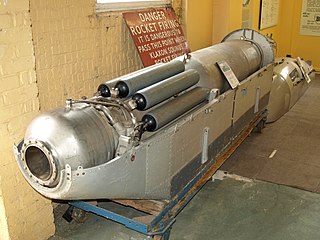
The de Havilland Sprite was a British rocket engine built by de Havilland in the early-1950s for use in RATO applications. A developed engine with slightly less thrust but a longer burn time was known as the Super Sprite, production ceased in October 1960.
The Armstrong Siddeley Snarler was a small rocket engine used for mixed-power experiments with an early turbojet engine. and was the first British liquid-fuelled rocket engine to fly.
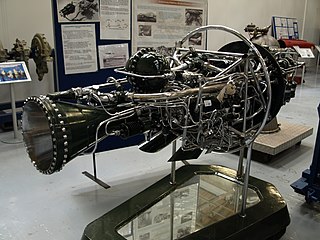
The Armstrong Siddeley Screamer was a British rocket engine intended to power the Avro 720 manned interceptor aircraft. Thrust was variable, up to a maximum of 8,000 lbf (36 kN).

Rocket propellant is the reaction mass of a rocket. This reaction mass is ejected at the highest achievable velocity from a rocket engine to produce thrust. The energy required can either come from the propellants themselves, as with a chemical rocket, or from an external source, as with ion engines.

The Société d'Études pour la Propulsion par Réaction (SEPR) was a French research and manufacturing company founded in 1944 which specialised in the development of liquid-fuelled rocket engines during the 1950s, 60s, 70s and 80s.
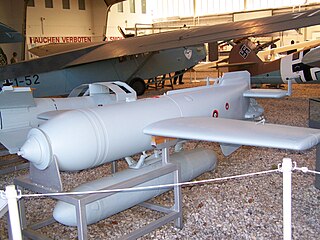
The HWK 109-507 was a liquid-propellant rocket engine developed by Germany during World War II. It was used to propel the Hs 293 anti-ship guided missile.
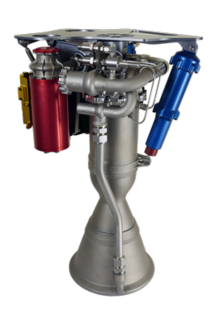
Rutherford is a liquid-propellant rocket engine designed by aerospace company Rocket Lab and manufactured in Long Beach, California. The engine is used on the company's own rocket, Electron. It uses LOX and RP-1 as its propellants and is the first flight-ready engine to use the electric-pump feed cycle. The rocket uses a similar engine arrangement to the Falcon 9; a two-stage rocket using a cluster of nine identical engines on the first stage, and one vacuum-optimized version with a longer nozzle on the second stage. This arrangement is also known as an octaweb. The sea-level version produces 24 kN (5,400 lbf) of thrust and has a specific impulse of 311 s (3.05 km/s), while the vacuum optimized-version produces 24 kN (5,400 lbf) of thrust and has a specific impulse of 343 s (3.36 km/s).
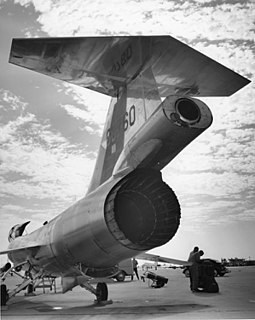
The Rocketdyne AR2, also known by the military designation LR42, was a family of liquid-fuelled rocket engines designed and produced in the United States (US) during the 1950s and 1960s.

















